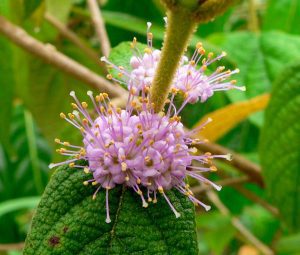Forest Flora – Great Wooly Malayan Lilac
 #ForestFlora – Callicarpa candicans, commonly known as a great wooly Malayan lilac or the purple-berried Malayan lilac, is an evergreen shrub or small tree, growing up to a maximum of 6 meters tall (with the average reaching around 2-4 meters).
#ForestFlora – Callicarpa candicans, commonly known as a great wooly Malayan lilac or the purple-berried Malayan lilac, is an evergreen shrub or small tree, growing up to a maximum of 6 meters tall (with the average reaching around 2-4 meters).
Callicarpa means ‘beautiful fruit’ – Greek ‘καλλος’ (kallos) translates to ‘beauty’, while ‘καρπος’ (carpos) translates to ‘fruit’; ‘candicans’ is Latin, and translates to ‘being whitish’.
Great wooly Malayan lilac is commonly cultivated as an ornamental in gardens, often selected for its colourful fruits.
This plant is a very useful one, used in traditional medicine. The leaves are depurative (considered to have purifying and detoxifying effects) and in traditional medicine practices of First Nation Peoples, the leaves are drunk to relieve abdominal discomfort. It’s also great for preventing and reducing swelling, while a decoction of the leaves and root is used as a wash for various skin conditions. It’s also believed that early settlers utilised the leaves as a mosquito repellent for themselves and their horses.
Information about medical qualities of plants is for interest only. This information is not intended to be used as a guide for the treatment of medical conditions.
The genus Callicarpa is widely distributed in warm temperate and tropical America, the West Indies, and eastern and southern Asia including tropical Australia and is part of the Lamiaceae or Labiatae family. Of the seven Australian species two are endemic in Australia (Callicarpa brevistyla and Callicarpa thozetii) and the other five are widely dispersed in Malesia (Callicarpa candicans, Callicarpa caudata, Callicarpa longifolia, Callicarpa macrophylla, and Callicarpa pedunculata).
The Lamiaceae or Labiatae are a family of flowering plants commonly known as the mint or sage family. Many of the plants are aromatic and include widely used culinary herbs like basil, mint, rosemary, sage etc. Some species are shrubs, trees, or, rarely, vines.
Information sourced from the Journal of the Adelaide Botanic Gardens and the Queensland Government.
Want more good Rainforest news in your life?
Subscribe to our eNews | Follow us on Instagram | Like us on Facebook | Subscribe to our YouTube channel
Help Protect Rainforests Forever
Donate to Protect Rainforests Forever | Become a Rainforest Guardian | Partnership Options

